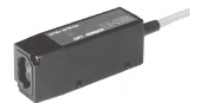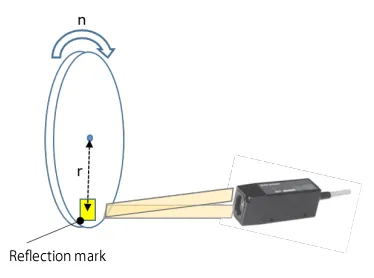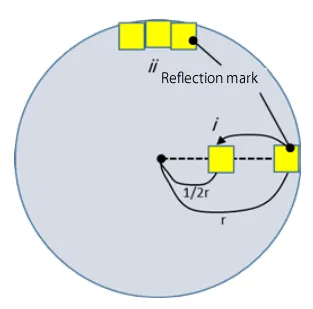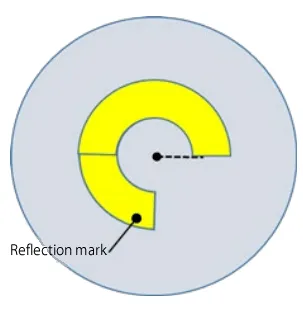No.47 How the measurable rotation speed is determined by the photoelectric detector?
Our photoelectric detectors such as LG-9200 and LG-930 are sensors for detecting the rotation speed of rotating objects such as motors in combination with the digital tachometer such as the TM-3100 series.
There is an item called "maximum response speed" in the specification. This defines the upper limit of rotation speed to be measured.
Photoelectric Detector
LG-930

Specification
Detection method :Visible ray photoelectric reflection
Detection distance :70 to 200 mm
Detection object :Reflection mark
Max. response speed:25 m/s
Why is the standard value of the sensor for detecting rotation speed "maximum response speed" instead of "maximum rotation speed"? A photoelectric detector emits light from the tip of the sensor, converts the light reflected by a reflection mark affixed to the object to be measured into electrical signals, and outputs rotation speed signals. In order to convert light into electrical signals, it is necessary to continue sensing the reflected light for a certain time. Therefore, time for the reflective mark to pass in front of the photoelectric detector is important. The speed of the reflection mark affixed to the object to be measured is determined not only by its rotation speed, but also by the size of the object (the distance from the center of object to the reflection mark). When measuring the rotation speed, it is necessary to calculate and check in advance whether the rotation speed you want to measure can be measured with this sensor.
Calculation method
If the distance from the center of the rotating object to the reflection mark is r (m) and the rotation speed is n (r/min), the moving speed V (m/s) where the reflection mark is affixed can be expressed as V=2πr × n /60 (m/s). If this value is 25 m/s or less, which is the maximum response speed of the LG-930, the signals that can be measured by pulse counter or tachometer can be obtained.
Let's calculate the maximum rotation speed that can be measured by the LG-930 when a reflection mark is affixed 10 cm from the center of rotation object.
The following relationship is completed between the speed V passing through the front of LG-930 and the rotational speed n.
V= 2πr x n ÷60
Since the LG-930 has a maximum speed of 25 m/s, it is necessary to satisfy formula.
V=2πr x n ÷60≦25······ ①
When calculating n by putting the numerical value in the above formula.
n ≤ 25 × 60 ÷ (2𝜋 ∗ 0.1)······②
n ≤ 2,387
it finds that the rotation speed can be measured up to 2,387 r/min.
Fig.1

How can we measure rotation speeds up to 4,000 r/min?
If the rotation speed is 4,000 r/min, the moving speed V is
V = 2π×0.1×4,000/60 ≒ 42 m/s
It greatly exceeds 25 m/s (=max. response speed), so we cannot detect the rotation signal.
There are two methods to increase the upper limit of rotation speed.
Method 1
To keep V unchanged as n increases, decrease r.
As shown in i in Fig. 2, move the reflection mark’s position closer to the center of the rotating body, making it to 5 cm, half of the original position.
The result of the formula is n ≤ 4,775, which makes it possible to measure the rotation speed of 4,000 r/min.
Method 2
As shown in Fig. 2 ii, multiple reflection marks are affixed side by side in the direction of rotation.
The longer the length of the reflection mark, the longer the transit time.
When affixing two reflection marks side by side, the transit time will be doubled even if the passing speed is the same, and you can measure up to twice the rotation speed. (If 3 reflection marks affixed, the rotation speed can be measured up to 3 times.)
Fig.2

The upper limit of rotation speed cannot increase infinitely. For example, as shown in Fig. 3, if the distance from the rotation center is short (1/2 r) and the reflection mark is affixed over 3/4 of the circumference, the rotation speed can be measured up to approximately 90,000 r/min. However, in fact, it cannot measure.
The area without the reflection mark is too narrow for the sensor to detect correctly. The notes in the specification, “at intervals of 48 mm” is for the sensor to distinguish whether the reflection mark is or not.
Fig.3

For LG-930, 1 (the length of the reflection mark):3 (the area without the reflection mark)
If multiple reflection marks are affixed to increase the response speed, please note that the area without reflection marks must be at least three times as length as the area with reflection marks.
Ex)
If a reflection mark is affixed on the outer circumference of a rotating shaft with φ20 to detect the rotation speed, the maximum rotation speed n is n ≤ 25 x 60/(2π x 0.02) ≒ 11,900 r/min. If another reflective mark is affixed, the ratio of with/without the reflection mark is 24 (=12x2) : 39 (=63-24). This ratio doesn’t meet the above condition. To meet the condition, the maximum length of the reflection mark must be below 16 mm or less.
Photoelectric detectors have different response speed depending on the product, so the maximum measurable rotation speed also differs. It is necessary to select a product considering the (expected) rotation speed to be measured, the size of the measurement target (distance from the center of rotation object to the measurement point), and the response speed of the detector.
(HO)
